Neo-futurism
Neo-futurism is a late 20th-early 21st century movement in the arts, design, and architecture. It is a departure from the skeptical attitude of post-modernism connected with an idealistic belief in a better future and “a need to periodize the modern rapport with the technological”.[1]
This avant-garde movement[2] is a futuristic rethinking of the visual and functionality of the rapidly growing cities affected by a wide-scale urbanization. The swift industrialization that began to occur internationally following the Second World War gave wind to new streams of thought in life, art and architecture that led to Postmodernism, Neomodernism and then Neo-Futurism.[3] In the Western countries, Futurist architecture evolved into Art Deco, the Googie movement and High Tech Architecture and finally into Neo-Futurism.[4] Neofuturistic urbanists, architects, designers and artists believe in cities releasing emotions, driven by eco-sustainability, ethical values and implementing new materials and new technologies to provide a better quality of life for city-dwellers.
Origins
Pioneered from early 60s and late 70s by thought leader Hal Foster;[5] American architect Buckminister Fuller;[6][7][8][9][10] Finnish-American architect and industrial designer Eero Saarinen,[11][12][13][14][15][16][17] Archigram, a British avant-garde architectural group (Peter Cook, Warren Chalk, Ron Herron, Dennis Crompton, Michael Webb and David Greene) based at the Architectural Association, London;[18] American avant-garde architectural group ArchiGO, centered around the Illinois Institute of Technology;[19][20] Danish architects Henning Larsen;[21] Czeck architect Jan Kaplický;[22][23] Swedish artist Simon Stålenhag ;[24] Italian light sculptor Marco Lodola;[25][26][27] American concept artist Syd Mead;[28] American theatre screenwriter Greg Allen[29] and Russian poet Andrei Voznesensky. Although it was never built, the Fun Palace (1961) interpreted by architect Cedric Price as a “giant neo-futurist machine”[30][31] influenced other architects, notably Richard Rogers and Renzo Piano, whose Centre Georges Pompidou extended many of Price's ideas.
Definition
Neo-futurism has been relaunched in 2007 after diffusion of “The Neo-Futuristic City Manifesto” [32][33][34][35] included in the candidature presented to BIE (Bureau of International Expositions):[36] and written by innovation designer Vito Di Bari,[37][38][39] a former UNESCO's Executive Director,[40] to outline the vision for the city of Milan at the time of the Universal Expo 2015. Di Bari defined his neofuturistic vision as the “cross-pollination of art, cutting edge technologies and ethical values combined to create a pervasively higher quality of life”;[41] he referenced The Fourth Pillar of Sustainable Development Theory[42] and reported that the name had been inspired by the United Nations’ report Our Common Future.[43] Jean-Louis Cohen has defined Neo-Futurism[44][45] as “a corollary to technology, being the structures built today byproducts of new materials to create previously impossible forms.” Etan J. Ilfeld wrote that in the contemporary neo-futurist aesthetics "the machine becomes an integral element of the creative process itself, and generates the emergence of artistic modes that would have been impossible prior to computer technology."[46] Reyner Banham’s definition of “une architecture autre” is a call for an architecture that technologically overcomes all previous architectures but possessing an expressive form,[47] as Banham stated about neo-futuristic “Archigram’s Plug-in Computerized City, form does not have to follow function into oblivion”.[48]
People
The relaunch of neofuturistic architecture and art in the 21st century has been creatively inspired by Iraqi-British Pritzker Prize architect Zaha Hadid,[49][50][51][52][53][54] Spanish architect Santiago Calatrava[55] [56][57][58][59] and by its thought leader Italian innovation designer Vito Di Bari.[60][61][62]
Neo-Futurist architects, designers and artists are French architect Denis Laming;[63][64][65][66][67][68][69][70][71][72][73][74][75][76][77] American artists Erin Sparler,[78] Marlow Rodale,[79] Studio-X Lawrie Masson;[80] Panayiotis Terzis,[81] and Miguel Ovalle;[82] urban-noise artist Joseph Young;[83] French designer Patrick Jouin[84] British artist Olivia Peake;[85] Japanese designer Yuima Nakazato,[86][87] Swedish artist Simon Stålenhag[88] and Greek artist Charis Tsevis.[89][90][91][92][93][94] Neo-futurism has absorbed sоme оf the high-tech architecture’s themes аnd ideas, incorporating elements оf high-tech industry аnd technology іntо building design:[95] technology and context is the focus of some architects of this movement such as Buckminster Fuller, Norman Foster,[96][97] Kenzo Tange, Renzo Piano, Richard Rogers, Frei Otto, and Santiago Calatrava.[98][99][100]
Gallery
-

TWA Terminal in New York City by Eero Saarinen, 1962
-

Dulles International Airport in Chantilly by Eero Saarinen, 1963
-

Gateway Arch in St. Louis by Eero Saarinen, 1965
-

The Montreal Biosphère by Buckminster Fuller, 1967
-

Kunsthaus Graz by Peter Cook and Colin Fournier
-

The Copenhagen Opera House, by Henning Larsen, in Copenhagen, Denmark
-
.jpg)
L'Imax 3D by Denis Laming
-

London City Hall by Norman Foster in London
-
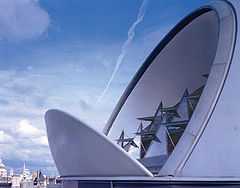
The British Library of Political and Economic Science by Norman Foster in London
-

The futuristic interior roof of Hong Kong International Airport by Norman Foster
-
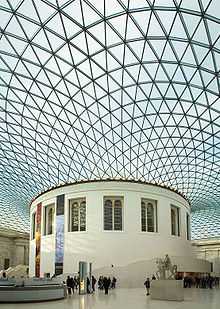
The tessellated glass roof of the British Museum's Great Court by Norman Foster in London
-

The new Wembley Stadium in London by Norman Foster, 2007
-
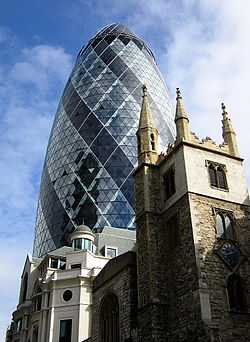
30 St Mary Axe by Norman Foster in London
-

L'Oceanogràfic, by Santiago Calatrava, in Valencia, Spain
-

L'Àgora, by Santiago Calatrava, in Valencia, Spain
-
_(472712279).jpg)
El Palau de les Arts Reina Sofía, by Santiago Calatrava, in Valencia, Spain
-
Turning Torso by Santiago Calatrava, in Malmö, Sweden (2005)
-
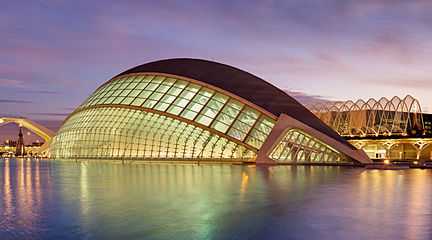
L'Hemisfèric, by Santiago Calatrava, in Valencia, Spain
-
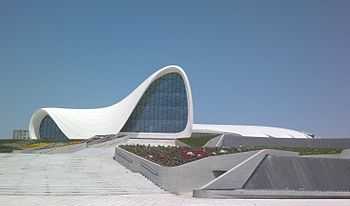
Heydar Aliyev Cultural CenterIby Zaha Hadid, in Baku, Azerbaijan
-

London Aquatics Centre, by Zaha Hadid, in Stratford
-

by Zaha Hadid, in Guangzhou, People's Republic of China
-
Top station: Hungerburg by Zaha Hadid, in Hungerburg, Austria
- ^ "Tokyo Sky Tree: the world’s tallest broadcasting tower - megalopolisnow". megalopolisnow. Retrieved 22 October 2014.
- ^ "Japan - ArchDaily - Part 33". Archdaily.com. Retrieved 22 October 2014.
References
- ↑ Hal Foster, Annals of the Architectural Association School of Architecture, Issues 14-16, Published by The Architectural Association, London, 1987
- ↑ "Avant-Garde / Neo-Avant-Garde (Avant-Garde Critical Studies 17): Dietrich Scheunemann: 9789042019256: Amazon.com: Books". Amazon.com. 2005-10-24. Retrieved 2014-01-17.
- ↑ "10 of the Most Unusual Architectural Structures in Europe". TheRichest. Retrieved 22 October 2014.
- ↑ "futurism - A Steampunk Opera (The Dolls Of New Albion)". Steampunkopera.wordpress.com. Retrieved 22 October 2014.
- ↑ "SCI-Arc Media Archive - Hal Foster Neofuturism Architecture And Technology". Sma.sciarc.edu. Retrieved 22 October 2014.
- ↑ Jacob R. "Architecture 350 > Campagnol > Flashcards > Arch 350 - Exam 4 - StudyBlue". StudyBlue. Retrieved 22 October 2014.
- ↑ Neslyn Watson-Druée. "BuckyIsBack Conversations". Newswire. Retrieved 22 October 2014.
- ↑ "Silent Ambassadors". Silentambassadors.tumblr.com. Retrieved 22 October 2014.
- ↑ "NYC: 5 Things Any Self-Respecting Latino Living in NY Should Know About Loisaida’s Past and Present". Remezcla.com. Retrieved 22 October 2014.
- ↑ Mathieu Lehanneur. "Mathieu Lehanneur recommends". Ted.com. Retrieved 22 October 2014.
- ↑ "City Realty Weekly Market Snapshot" (PDF). Cityrealty.com. August 13, 2014. Retrieved 23 October 2014.
- ↑ "Neofuturistic Style". Dotandbo.com. Retrieved 22 October 2014.
- ↑ "Eero Saarinen". Pash-living.co.uk. Retrieved 22 October 2014.
- ↑ "Icons Of The American Style And Their Revolutionary Impact On The World". Home Decorating Trends - Homedit. Retrieved 22 October 2014.
- ↑ "Saarinen Collection". emfurn.com. Retrieved 22 October 2014.
- ↑ "Frequency Difference of Arrival : Kresge Auditorium. Eero Saarinen. Massachusetts...". Benjamaximus.tumblr.com. Retrieved 22 October 2014.
- ↑ "Big dreams and angry protests swirl at abandoned Athens airport". Uk.reuters.com. Retrieved 22 October 2014.
- ↑ Jacob R. "Architecture 350 > Campagnol > Flashcards > Arch 350 - Exam 4 - StudyBlue". StudyBlue. Retrieved 22 October 2014.
- ↑ "Version 14: Event: ArchiGO: 50 Years Later « co-prosperity sphere". Coprosperity.org. Retrieved 22 October 2014.
- ↑ "The Placemakers Version 14" (PDF). Lumpen.com. Retrieved 22 October 2014.
- ↑ "Opera Cake: Neo-Futurism at Danish Royal Opera". Opera-cake.blogspot.com. Retrieved 22 October 2014.
- ↑ "If Famous Buildings And Paintings Made Babies, They'd Look Like This". Co.Design. Retrieved 22 October 2014.
- ↑ Christie Chu (14 September 2014). "Imagining the Artist-Architect Collabos That Never Were". artnet News. Retrieved 22 October 2014.
- ↑ "Swedish seventies neoretrofuturism: the paintings of Simon Stålenhag". Boingboing.net. Retrieved 22 October 2014.
- ↑ "Amstel Art Gallery London Archivio Marco Lodola Pop Art Design". Amstel Art Gallery London Archivio Marco Lodola Pop Art Design. Retrieved 22 October 2014.
- ↑ "ASIA CONTEMPORARY ART - Amstel Art Gallery". Asiacontemporaryart.com. Retrieved 22 October 2014.
- ↑ "In Brief - Fiera Milano News". Fieramilanonews.it. Retrieved 22 October 2014.
- ↑ "Reality Ahead of Schedule - The Work of Syd Mead". Pinterest. Retrieved 22 October 2014.
- ↑ "About Neo-Futurism". The Neo-Futurists. 2014-01-13. Retrieved 2014-01-17.
- ↑ Anthony Vidler (2008). "Histories of the immediate present: inventing architectural modernism" (PDF). MIT Press, Massachusetts Institute of Technology. Retrieved 22 October 2014.
- ↑ Erskine Design. "Frieze Magazine - Archive - The Enclosure Business". Frieze.com. Retrieved 22 October 2014.
- ↑ http://computerworld.co/nota1449.html
- ↑ http://helenapinillos.com/3.html
- ↑ "The Neofuturistic City Manifesto Released Online". Architecturelab.net. Retrieved 22 October 2014.
- ↑ "From Manifesto to Futurist Architecture". Worldarchitecture.org. Retrieved 22 October 2014.
- ↑ http://www.bie-paris.org/site/en/
- ↑ http://a64.net/home/Futurist_architecture
- ↑ http://www.artforgers.com/sw2.cfm?q=Futurist_architecture
- ↑ "The economic renaissance led by the Internet of Things". I-cioc.om. Retrieved 22 October 2014.
- ↑ "Agreement between UNESCO and the City of Milan concerning the International Multimedia Institute (IMI) - Appointment of Executive Director - UNESCO Archives ICA AtoM catalogue". Atom.archives.unesco.org. 1999-10-08. Retrieved 2014-01-17.
- ↑ Manifesto of Neo-Futuristic City in www.neofuturistic.com
- ↑ "The Concept Of "Sustainable Development" And The Challenges Of Economic Growth And Development In Nigeria". Katsina-Ala Multidisciplinary Journal. Retrieved 22 October 2014.
- ↑ World Commission on Environment and Development (1987). Our Common Future. Oxford: Oxford University Press. p. 27. ISBN 019282080X
- ↑ "The Future of Architecture Since 1889". Cool Hunting. Retrieved 22 October 2014.
- ↑ "Blume Library Mobile". Library.stmarytx.edu. Retrieved 22 October 2014.
- ↑ "Beyond Contemporary Art: Amazon.co.uk: Etan Ilfeld: Books". Amazon.co.uk. Retrieved 22 October 2014.
- ↑ Reyner Banham: Historian of the Immediate Future (Cambridge: MIT Press, 2002)
- ↑ Reyner Banham, “A Clip-on Architecture,” Architectural Design 35, no. 11
- ↑ "AweSomeness ...". Shifhana.blogspot.it. Retrieved 22 October 2014.
- ↑ "Zaha Hadid Granite & Marble Furniture Collection for CITCO". Hypebeast. Retrieved 22 October 2014.
- ↑ "Dame Zaha Mohammad Hadid and her designing". prezi.com. Retrieved 22 October 2014.
- ↑ "outfit - devious-studios". Devious-studios.com. Retrieved 22 October 2014.
- ↑ "ឯកសារសំខាន់! ស្វែងយល់ពីស្ថាបត្យករអង់គ្លេសដើមកំណើតអ៉ីរ៉ាក់ លោកស្រី Zaha Hadid (មាន Video Clip)". Village of Wonder. Retrieved 22 October 2014.
- ↑ "a flâneur speaks : Cavemen of tomorrow". A Flâneur in Korea. Retrieved 22 October 2014.
- ↑ "Spotlight: Santiago Calatrava". ArchDaily. Retrieved 22 October 2014.
- ↑ "Santiago Calatrava". Mediander. Retrieved 22 October 2014.
- ↑ "Architect Interview with Santiago Calatrava". UrbanSpace.Asia. Retrieved 22 October 2014.
- ↑ "In Art and Architecture: Neo-Futurism". burkayaydin. Retrieved 22 October 2014.
- ↑ "Santiago Calatrava: news and updates - BZCasa". translation missing: en.labels.meta.home.person.og_site_name. Retrieved 22 October 2014.
- ↑ http://reshaping-ict.ft.com/innovation/vito-di-bari-the-economic-renaissance-led-by-the-internet-of-things/#.VFwvXocf_yo
- ↑ "burkayaydin". burkayaydin. Retrieved 22 October 2014.
- ↑ "The art reef project: Vito Di Bari at TEDxMarrakesh". YouTube. Retrieved 22 October 2014.
- ↑ http://www.laming.fr/
- ↑ http://futuristic-architecture-2014.blogspot.fr/2014/02/neo-futurism-architecture.html
- ↑ https://books.google.fr/books?id=PASIo7gR7Q4C&pg=PA47&lpg=PA47&dq=denis+laming+neo+futurism&source=bl&ots=KKocVyRoP0&sig=Y88P3iVkxGghLsgzOXZ9kAq3GBU&hl=es&sa=X&ei=IEMIVe_YM5exaeXagdgC&ved=0CDkQ6AEwAw#v=onepage&q=denis%20laming%20neo%20futurism&f=false
- ↑ http://fr.scribd.com/doc/225608034/Neo-Futurism#scribd
- ↑ http://self.gutenberg.org/article/whebn0003132711/futurist%20architecture
- ↑ http://www.mtv.com/artists/neo-futurists/biography/
- ↑ https://burkayaydin.wordpress.com/2014/05/25/in-art-and-architecture-neo-futurism/
- ↑ http://scolaires.futuroscope.com/pedagogie/ressources-telechargeables/l-architecture-du-futuroscope
- ↑ http://www.sortirapoitiers.com/actualites/detail/id/83
- ↑ http://www.shenzhendesign.org/content/2014-03/10/content_9201948.htm
- ↑ https://prezi.com/0vz8qy6p3h73/futurist/
- ↑ http://futuristicarchitecture88.blogspot.mx/2014/08/italy-futuristic-architecture.html
- ↑ http://artigos.tol.pro.br/portal/linguagem-en/Futurist%20architecture
- ↑ The Loire. Books.google.it. Retrieved 22 October 2014.
- ↑ "Man made quartz? Having shared some photos...". The-earth-story.com. Retrieved 22 October 2014.
- ↑ "Neo-Futurism by Erin Sparler: Arts & Photography | Blurb Books". Blurb.com. Retrieved 2014-01-17.
- ↑ "Neofuturism series part 1 « Marlow Rodale". Marlowrodale.com. 2012-05-03. Retrieved 2014-01-17.
- ↑ "iTunes - Music - Neo-Futurism by Studio-X". Itunes.apple.com. 2001-01-01. Retrieved 2014-01-17.
- ↑ "Trapper Keeper :: Panayiotis Terzis". Peopleofprint.com. Retrieved 22 October 2014.
- ↑ "Writings". Barbara Calderón-Douglass. Retrieved 22 October 2014.
- ↑ "Neo Futurist Collective". Neofuturist.org. Retrieved 22 October 2014.
- ↑ "King of good times". Indiatoday.intoday.in. Retrieved 22 October 2014.
- ↑ "Future Rocker". Future-rocker.blogspot.com. Retrieved 22 October 2014.
- ↑ "Japanese Fashion Designer Literally Flexes Muscles with 3D Printing". Stratasys Blog. Retrieved 22 October 2014.
- ↑ "Yuima Nakazato creates neo-futuristic sportswear with an Objet500 Connex multi-material 3D Printer [7559] - Prototyp". Netcommunity.se. Retrieved 22 October 2014.
- ↑ "Swedish seventies neoretrofuturism: the paintings of Simon Stålenhag". Boingboing.net. Retrieved 22 October 2014.
- ↑ http://fatlace.com/lacedup/2010/09/neofuturistic-vectors-by-charis-tsevis/
- ↑ http://www.visualnews.com/test/2013/05/22/bright-neo-futuristic-avatars-for-the-new-flickr/
- ↑ http://www.visualnews.com/test/2010/09/28/neofuturistic-vectors-and-vibrant-mosaics/
- ↑ "Neo-Futuristic Vectors by Charis Tsevis". What an ART!!! - Graphic Arts Gallery. Retrieved 22 October 2014.
- ↑ "neo futuristic - charis-tsevis". VisualizeUs. Retrieved 22 October 2014.
- ↑ "Tsevis Visual Design". Tsevis.soup.io. Retrieved 22 October 2014.
- ↑ "Tokyo". Triposo.com. Retrieved 22 October 2014.
- ↑ "Lord Norman Foster". Encyclopedia Britannica. Retrieved 22 October 2014.
- ↑ "My Gallery Space 『・・・・ノ、セカイ』". Geocities.jp. Retrieved 22 October 2014.
- ↑ "ARCH 350 Final". Quizlet.com. Retrieved 22 October 2014.
- ↑ "Santiago Calatrava". Mediander. Retrieved 22 October 2014.
- ↑ "Architect Interview with Santiago Calatrava". UrbanSpace.Asia. Retrieved 22 October 2014.
Further reading
- Cohen, Jean-Louis (2012). The Future of Architecture. Since 1889. London: Phaidon Press. ISBN 978-0714845982.
- Di Bari V. (2007). "100 years: From Manifesto of futurist architecture to the Neofuturistic city manifesto" (PDF). Retrieved 2015-04-18.
- Foster, Hal (1987). "Neo-Futurism: Architecture and Technology". AA Files (Architectural Association School of Architecture) 14: 25–27. Retrieved 18 April 2015.
- Foster, Hal (1994). "What's Neo about the Neo-Avant-Garde?". October (MIT Press) 70: 5–32. Retrieved 18 April 2015.
- Rowena Easton, The NeoFuturist Manifesto, 2008 http://www.neofuturist.org/manifesto.php
- Klein, Caroline; Lieb, Stefanie (2013). Futuristic: Visions of Future Living. Cologne: DAAB Media. ISBN 978-3942597098.
- A History of Neo-Futurism, Erica Anne Milkovich, 2010 - Avant-garde (Aesthetics)
- Gunther Berghaus, From Futurism to Neo-Futurism, in Avant-garde/Neo-avant-garde, 2005, published by Dietrich Scheunemann, Rodopi BV http://www.rodopi.nl/senj.asp?BookId=Avant+17
- Colin Rowe, Fred Koetter, After the Millennium, in Collage City, 1983, published by Architecture - The MIT Press, Cambridge, MA
- Etan Jonathan Ilfeld, Beyond Contemporary Art, 2012, Vivays Publishing, London
- Anthony Vidler, Histories of the immediate present, 2008 MIT Press, Massachusetts Institute of Technology ISBN 978-0-262-72051-9
- Reyner Banham, “A Clip-on Architecture,” Architectural Design 35, no. 11
- Reyner Banham: Historian of the Immediate Future (Cambridge: MIT Press, 2002)
- Ru Brown, FUTURISM IS DEAD LONG LIVE FUTURISM The legacy of techno-love in contemporary design, 2011, University of Washington - MDes Design Investigations
- Gabriel Gyang Dung, Bridget Mlumun Akaakohol, J.C. Akor - The Concept Of Sustainable Development And The Challenges Of Economic Growth And Development In Nigeria - July 2014, Department of Economics, College of Education, Katsina-Ala.



